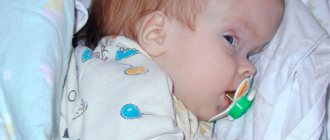Obsessive-compulsive neurosis - symptoms and treatment
Psychoanalytic theory. According to Freud, obsessive thoughts arise from the suppression of aggressive and sexual drives. These symptoms develop as a result of regression to the anal stage (the second stage of psychosexual development according to S. Freud, which begins at the age of 18 months and ends by three years) [7]. Regression depends on one of the following factors or a combination of them:
- defensive ego;
- residual phenomena of the anal-sadistic stage of development;
- phallic organization [3].
There was no objective evidence in the stated theory, so only some scientists consider it possible to consider it as an explanation for the cause of OCD.
Neurochemical theory. This theory was put forward by I.P. Pavlov; it is based on the role of acetylcholine and adrenaline metabolism [14]. Further, the occurrence of OCD has been described as a result of disturbances in serotonin metabolism.
The evidence was a comparison of the effectiveness of serotonin reuptake inhibitors, non-serotonergic drugs and placebo tablets in OCD. Strong correlations between plasma levels of clomipramine (an antidepressant) and reduction in OCD symptoms further supported the role of serotonin in the development of this disorder. However, the study of serotonin metabolism in OCD patients has not yet been sufficiently effective. Contrary to this theory, clomipramine is in some cases better at reducing OCD symptoms than selective serotonin reuptake inhibitors such as fluoxetine, fluvoxine and sertraline [4].
Neuroanatomical theory. Based on the results of special studies, neuroanatomical justifications for OCD were obtained. Frontal lobe dysfunction has been identified in many patients with OCD, but only a few researchers have been able to confirm this. Additional evidence for the involvement of the frontal lobe in the development of OCD has been the use of effective psychosurgical techniques such as capsulotomy and cingulotomy (targeted damage to brain structures whose activity causes the disease).
Evidence of neurobiological disorders in OCD is the connection of this disorder with another pathology, which is based on processes in the basal ganglia (lethargic encephalitis, Sydenham's chorea and Gilles de la Tourette's syndrome). Also, based on the results of four studies that assessed the metabolic activity of the brain using positron emission tomography, it was proven that metabolism in this disorder is increased in the prefrontal cortex [4].
Back Next
The following types of obsessive phenomena are distinguished:
Three main groups of obsessive phenomena:
- In the ideational sphere - obsessions (obsessive thoughts, memories, doubts and desires).
- In the emotional sphere - phobias.
- In the motor sphere - compulsions.
All obsessive phenomena can be divided into abstract (they do not cause any significant emotional experiences, although their presence may tire or cause some irritation) and figurative obsessions (causing emotional stress, subjectively difficult for a person to bear).
Intrusive thoughts
• “Mental chewing gum” (morbid philosophizing) is an obsessive state consisting of constant useless and aimless thinking about the nature of things.
• Obsessive counting (arithmomania) - an obsessive desire to count objects that catch the eye: floors of houses, pillars, people in general and men or women in particular, cars of a certain color or brand, etc.
• “Blasphemous thoughts” (contrasting obsessions) - obsessive thoughts whose content is incompatible (contrasting) with the ethical attitudes of the individual. Thoughts that contradict beliefs or faith, mental curses at people close to or respected by a person, mental wishes for them of all kinds of troubles and misfortunes, obscene ideas about them. Usually such thoughts, which contrast with a person’s conscious attitudes, greatly upset him and cause mental anguish, but he cannot get rid of them. For example, during church services, a true believer patient began to come to mind obscene ideas about the priests she respected and the saints she revered, their vices and physiological functions; she perceives this as a sin, tries to drive it away from herself, but is unable to do it.
Obsessive doubts - lack of confidence in the correctness and completeness of the actions taken. Doubts are unfounded, but a person constantly returns to thoughts about whether he did everything exactly as it was necessary; it is based on a distorted assessment of the real probability of a particular event. If a completed action can be verified, this is done repeatedly, to the point of exhaustion. For example, when leaving home, a person repeatedly returns to the door, pulls the handle, checking whether he has closed the door. Such a test cannot be considered a pathology if it is repeated 1-2 times, especially in a state of fatigue (when tired, concentration of attention, which is necessary to track the sequence of actions performed, is impaired). However, in some cases, checking whether the door is closed, whether electrical appliances and water taps are turned off, etc. forces a person to return home 8–10 times, including from a long distance from home, which leads him to be very late for work or school, and sometimes does not allow him to leave home at all. At the same time, there are actions that cannot be verified, for example, whether you pushed a random fellow traveler on the subway or pricked him with an umbrella. In these cases, thoughts about such actions torment a person for a long time, forcing him to go over in his mind all the aspects of how certain events occurred. In most cases, obsessive doubts are accompanied by anxiety.
As already noted, each of us, to one degree or another (depending on personal characteristics), is characterized by obsessive doubts. However, how do they affect medical work? On the one hand, obsessive doubts about the correctness of one’s actions (especially those responsible) force one to return to them (including mentally) again and again, adjust prescriptions, repeat examinations, and postpone interventions. To reduce doubts, the doctor begins to perform his manipulations and make notes in the medical documentation in excessive detail and for a long time. All this takes up a lot of his working time, and sometimes can directly harm patients. In addition, an insecure doctor who doubts the correctness of his actions does not inspire confidence in his patients. On the other hand, it is precisely doubts that one is right and the desire to do better that forces the doctor to think, look for the approaches needed in this case, take into account additional factors, study new literature and modern techniques. A doctor, deprived of the ability to doubt his own rightness, is capable only of stereotyped thinking, he does not develop, does not learn new things. Such a doctor is satisfied with what he already knows and can do, but medicine is an extremely voluminous and rapidly developing industry, it is impossible not to study in it, so doctors who do not do this quickly become dangerous for their patients. Accordingly, as elsewhere in medicine, a balance is needed, a golden mean between the tendency to excessive doubts and their absence, between “thinking, but not doing” and “doing, but not thinking.”
Intrusive memories are persistent thoughts about events that actually happened in the past. Often the content of these events, for one reason or another, is unpleasant and painful for a person, so it would be natural to want not to remember it, but memories, often figurative, return again and again, causing unpleasant emotional experiences.
In other cases, memories reflect emotionally neutral events, for example, conversations between friends that are not burdened with high meaning, fragments of books read, films watched, melodies heard, poems learned before, dates, names. In some cases, these memories are represented by very vivid, vivid images, such as the haunting sound of a popular song (obsessive eidetic images). Like morbid philosophizing (“mental chewing gum”), they are more likely to tire you than to evoke any other emotions.
Obsessive urges. In a broad sense, obsessive drives could include many aspects of a person’s life associated with the emergence of his desires and their implementation (for example, love, as an obsessive attraction to another person). But in psychopathology, obsessive drives are viewed in a narrow sense, primarily as a desire to commit a meaningless, dangerous or obscene act. The danger and inappropriateness of such attractions is well understood, but a person cannot get rid of them; anxiety and fear arise to take appropriate actions. So, for example, fear of heights may not be caused by the perception of height itself, but by the initial fear of succumbing to an inexplicable attraction and jumping down. The same applies to the fear of sharp objects. The emergence of obsessive drives often leads to avoidant behavior. For example, a young mother living with her family on the third floor of a house with wide flights of stairs refuses to carry her infant child up the stairs, asking her husband, grandmother, and, when they are not there, neighbors to do it. She explains this by saying that, while walking up the stairs, she has an inexplicable and “unnatural” desire to throw the child down, begins to vividly imagine how this could happen, which causes a strong attack of fear, her legs give way, and she cannot walk. Despite their intensity, such dangerous obsessive desires are never realized (unlike impulsive ones).
They also talk about obsessive attraction in relation to addictive behavior disorders (alcoholism, drug addiction, gambling addiction, etc.). In these cases, the attraction to a psychoactive substance or one’s version of addictive behavior is realized, its possible harmful consequences are also realized, and a “struggle of motives” arises (weighing the pros and cons). However, the desire somehow returns again and again, and since it does not pose an immediate danger to the patient (of course, for example, continued drinking is dangerous to the patient’s health in the sense that it has harmful consequences, but there is no immediate danger), to a large extent cases it is carried out (i.e. the patient who has an urge to drink actually drinks).
Obsessive fears (phobias) - see next section.
Obsessive actions (compulsions, from the Latin compello - I force ) - an insurmountable desire to perform certain movements or actions. There are two types:
a) “Protective” actions in case of fears and doubts. They may have a meaning directly related to the content of the phenomena that caused them. For example, constant hand washing in case of fear of contamination (mysophobia), double-checking whether the door is closed (in case of obsessive doubts of the corresponding content). But they can also have some indirect meaning, being a symbolic protection against impending disaster. Such actions are called “rituals”; they can be very diverse: pinching yourself painfully, spinning around in place, putting a coin in your shoe, taking a “lucky” teddy bear with you on a business trip, etc. Failure to perform protective behavior causes increased emotional stress and obsessions. In a number of cases, protective actions lose connection with the fears that caused them and become an independent form of obsessive phenomena for the patient (for example, constant hand washing, initially associated with the fear of contamination, over time begins to be performed without any connection with contact with dirty objects, but simply by itself yourself, otherwise strong emotional disturbance arises);
b) simple - not accompanied by emotional experiences. This includes habitual, fixed, stereotypical movements (for example, straightening hair, rubbing hands, special facial movements, etc.), walking in a certain way on tiles on the sidewalk, whistling melodies, etc. With an effort of will, these movements can be stopped for a short time, but then they come back again.
In addiction, a compulsive desire to use psychoactive substances is an intractable attraction caused by physical dependence.
Back Next
To see comments you must register
Treatment of OCD at the Mental Health Clinic
At the Mental Health clinic, under the leadership of its founder, MD, psychiatrist V.L. Minutko, the author of the book “Obsessive Disorders” (the first complete guide to this problem in 100 years), has experienced doctors who have been successfully treating obsessive-compulsive disorders for more than ten years.
In our clinic, treatment of obsessive disorders is carried out comprehensively and strictly according to an individual program . We take into account not only the clinical picture of the disease, but also the personal data of each individual patient. It is necessary to start treatment as early as possible - only in this case will it be as effective as possible.
One of the advantages of our clinic is that the diagnosis and future treatment plan is necessarily discussed with the patient. The doctor introduces the patient to the basic methods used to treat obsessive-compulsive disorders, the examinations performed, as well as the clinical symptoms of the disease (we have found that obsessive-compulsive neurosis is caused by chronic infections, such as staphylococcal or streptococcal).
The clinic's medical facilities include an outpatient center in Moscow, as well as a 24-hour sanatorium-type hospital in the Moscow region with the possibility of accommodation for relatives. Depending on the indications, as well as personal preferences, patients can choose the most suitable treatment option for themselves.
Diagnosis of OCD
According to the International Classification of Diseases (ICD-10), to make a diagnosis, it is important that obsessions and/or compulsions have been observed with noticeable frequency for at least two consecutive weeks and are accompanied by a state of distress. Symptoms must have the following characteristics:
- The patient's thoughts or impulses are his own, not caused by external factors.
- There is at least one thought or action that the patient tries unsuccessfully to resist.
- The thought of performing a compulsive action is in itself unpleasant (merely reducing tension or anxiety is not considered pleasant in this sense).
- Thoughts, images, or impulses repeat themselves in a stereotypical manner.
When diagnosing OCD, it is important to separate its symptoms from those of other diseases. Obsessions and compulsions can develop during exacerbations of schizophrenia, as well as with Tourette's syndrome. Problems similar to OCD may also be characteristic of obsessive-compulsive personality disorder. But if people with OCD realize that their obsessive actions are irrational, and they themselves experience discomfort from them, for a person with a personality disorder, the obsessive desire for accuracy is perceived as a manifestation of perfectionism and brings him pleasure.











